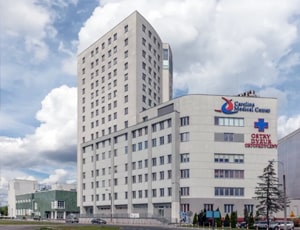Treatment cost

Apart from in-detail treatment procedures available, Carolina Medical Center located in Warsaw, Poland has a wide variety of facilities available for International Patients. Some of the facilities which are provided by them are Accommodation, Airport Transfer, Choice of Meals, Interpreter, SIM, TV inside room. Also listed below are some of the most prominent infrastructural details:

Craniotomy surgery is one of the most common types of brain surgery conducted to treat a brain tumor. It mainly aims at removing a lesion, tumor, or a blood clot in the brain by opening a flap above the brain to access the targeted area. This flap is removed on a temporary basis and again put in place when the surgery is done. Around 90 percent of the cases of brain tumors are diagnosed in adults aged between 55 and 65. Among children, a brain tumor is diagnosed within an age range of 3 to 12 years.
Craniotomy procedures are conducted with the help of magnetic resonance imaging (MRI) scans to reach the location precisely in the brain that requires treatment. A three-dimensional image for the same is achieved of the brain in conjunction with localizing frames and computers to view a tumor properly. A clear distinction is made between abnormal or tumor tissue and normal healthy tissue and to access the exact location of the abnormal tissue.
In a minimally invasive craniotomy procedure, a burr hole or a keyhole may be created to access the brain to fulfill the following purposes:
When there are complex craniotomies involved, the procedure may be referred to as a skull base surgery. In this kind of surgery, a small portion of the skull is removed from the bottom of the brain. This is the region where delicate arteries, veins, and cranial nerves exit the skull. Complicated planning is done to plan such craniotomies and understand the location of the lesions. This type of approach is usually employed for:
Primary brain tumors are much less common than secondary brain tumors. Primary ones are found to originate very close to the brain itself or in the tissues very close to it, such as the covering membranes of the brain, including the meninges, cranial nerves, pineal, or pituitary gland. It begins with normal cells, which at a later period undergoes some mutational errors in their DNA. The mutation triggers cells to grow and divide at a very high rate while healthy cells keep dying around it. This results in a mass of abnormal cells which gives rise to a tumor. Unlike primary tumors, the secondary tumors begin as cancer elsewhere and spread to the brain.
No matter what the goal of the surgery is, it is best to ensure that the incision is made to address the intracranial lesion keeping some principles in mind. A wide variety of intracranial processes can be done via a craniotomy with a different variety of incisions. Some of these variations include frontal craniotomy, pterional craniotomy, temporal craniotomy, decompression craniectomy, and suboccipital craniotomy.
Ask your healthcare adviser for the best multiple options and choose the one that meets your expectations
Craniotomy cost in Warsaw varies from one hospital to the other. The top hospitals for Craniotomy in Warsaw covers all the expenses related to the pre-surgery investigations of the candidate. Typically, the package cost of Craniotomy in Warsaw includes the expenses related to the surgeon's fee, anesthesia, hospital, meals, nursing and ICU stay. Post-surgical complications, new findings and delayed recovery may have an impact on the total Craniotomy cost in Warsaw.
Craniotomy in Warsaw is offered by multiple hospitals across the country. Some of the best hospitals for Craniotomy in Warsawinclude the following:
After Craniotomy in Warsaw, the patient is supposed to stay in guest house for another 23 days. During this time, the patient undergoes medical tests and consultations. this is to ensure that the treatment was successful and the patient us safe to return.
Apart from the Craniotomy cost, the patient may have to pay for additional daily expenses such as for guest house after discharge and meals. These include the cost of accommodation and meals outside hospital. The per day cost in this case may range from 55 USD.
The patient has to spend about 5 Days in the hospital after Craniotomy for proper recovery and to get clearance for discharge. The doctors team review the patient's recovery during this time with the help of blood tests and imaging scans. Once they feel that everything is on track, the patient is discharged.
There are more than 1 Hospitals that offer Craniotomy in Warsaw. These hospitals have the required infrastructure and a decided Craniotomy unit where renal failure patients can be treated. Such hospitals follow all legal protocols and guidelines as specified by the local medical affairs body when it comes to the treatment of international patients.